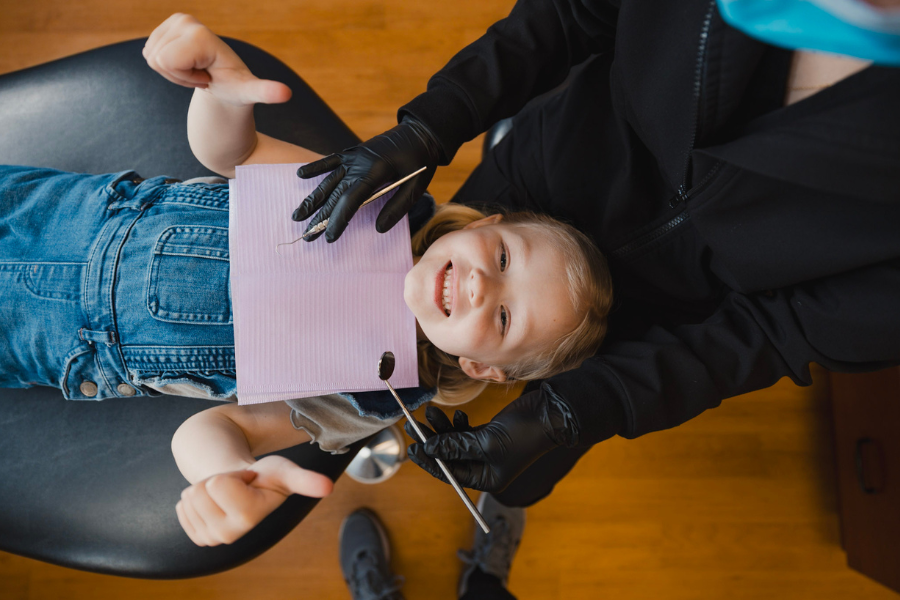Wondering why your child’s adult teeth look yellow? Learn why it’s normal, when to be concerned, and how to maintain a healthy, bright smile.
It’s an awesome coming-of-age moment when your child’s first adult tooth grows in. Adult teeth are bigger, shaped differently, and begin to form their smile that will last a lifetime. If you’re worried about your child’s adult teeth because they’re coming in yellow, it’s really nothing to fret over. Children’s adult teeth are normally a shade of yellow temporarily. We’ll explain why in this article and dive into a few abnormal cases where their teeth’s coloring might signify an underlying problem.
Causes of Yellow Teeth in Children
Adult Teeth Have a Yellow Tint
Adult teeth can range in color from white to light yellow and still be healthy. Baby teeth are extremely white because they’re made of mostly enamel. Adult teeth still have a good amount of enamel, but underneath the white enamel is dentin. As a material, dentin is more yellow in color, thus making the white enamel appear a bit more yellow.
Healthy enamel can range from extremely white to a tinted yellow. Most of this is determined by genetics, but age and lifestyle can affect the tint too. Most children will not have any severe staining as children do not smoke or regularly drink wine or tea. If children do have dark stained teeth or visible pits/deformities, it’s either because the tooth is hypoplastic (didn’t form correctly), has a genetic stain, or perhaps their teeth have fluorosis.
They’ll Become Whiter Overtime
As your child’s teeth erupt, they’ll be at their yellowest. Overtime, the enamel calcifies, giving the tooth a much whiter appearance. This calcification process can take several months after the tooth has appeared in the mouth, so remember to keep it clean and healthy while you’re waiting for the white pigment to come in.
Fluorosis
There are circumstances where a child’s permanent teeth are an unnatural yellow or brownish tint. When a child drinks water with high fluoride content as their permanent teeth form, they might develop fluorosis. Teeth with fluorosis are stained yellow to dark brown and occasionally have visible pits, but on the upside, they’re extremely resistant to developing cavities.
Fluorosis can range from very mild, where a few teeth might have some yellow staining, to severe cases, where the teeth are stained with a dark brown and have highly noticeable pits. Severe cases are rare, but less than one fourth of the population of the United States has developed some form of fluorosis.
Treatment for Fluorosis
Depending on the severity of fluorosis, you and your child have a few options. If the teeth are only mildly affected by fluorosis, whitening teeth can brighten the appearance of yellow stains. If the teeth are severely affected by fluorosis, white crowns or veneers can improve the teeth’s appearance.
Poor Dental Hygiene
If your child’s teeth are not stained, but just have a visible yellow appearance, it could be plaque build-up. Plaque is a film of bacteria that collects on the teeth, and if it is not regularly brushed off, it will form cavities. It has a slightly yellow tint to it, and if it turns into tartar, it’ll have a yellow to orange tint.
Teeth Trauma
Teeth can become discolored when they’re dead. If your child has hit their mouth hard, the teeth can turn a dark yellow, brown, or gray color. A tooth’s coloring reflects the health of the tooth’s pulp (root). When a tooth is alive and well, the colors range from white to light yellow. If the tooth has become extremely discolored like gray, brown, or dark brown, it’s time to get your child to the dentist as soon as possible. If the tooth is dead, there is still a chance to save it.
Tetracycline
The antibiotic tetracycline is not to be given to children under the age of 7 and pregnant mothers. Tetracycline is used to clear respiratory infections or infections within the nose or eyes, but there are other antibiotic alternatives better suited for children. While it causes birth defects in developing fetuses, it also has developmental side effects for young children. One of the issues tetracycline causes in young children is a permanent yellowing of the child’s adult teeth.
Whitening Children’s Teeth
Children that are in their teenage years are much better candidates for professional whitening kits and treatments than small children. Young children have fewer options to remove stains from their teeth because their teeth are either still developing or their gums are likely to be too sensitive to the whitening gels. Whitening toothpaste is not as effective as professional whitening kits because they don’t contain any bleach, but it’s more age-appropriate for young children who wish to whiten their teeth.
Schedule an Appointment
While in most cases yellow adult teeth are very normal, it’s completely understandable if you’re suspicious the pigment is indicating a bigger problem. If the tooth is darker brown or grey, give us a call as soon as possible and we’ll schedule an emergency exam.
If your child’s teeth are just yellow, keep brushing and flossing them daily and keep an eye on it. Yellowing does not indicate any serious conditions, but we can always discuss options over the phone or at your child’s appointments. We’re excited to see you soon!
.webp)


.png)

.png)




